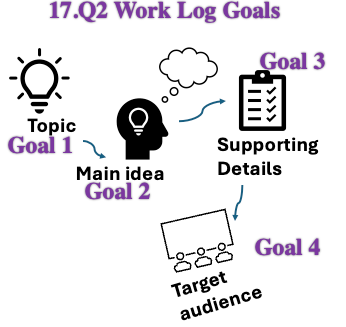Q2 The Main Idea Step 2
WORK LOG GOAL 2: IDENTIFY THE MAIN IDEA
- Review the articles to identify one you will use
- Play the video, Main Idea and Supporting Details YouTube (3:30) to learn how to identify the Main Idea and Supporting Details of a text
- Identify the main idea of the article
Main Idea and Supporting Details YouTube (3:30)
WORK LOG GOAL 3: IDENTIFY THE SUPPORTING DETAILS
- Identify three or four supporting details
- Brainstorm and draft an outline of the main idea and supporting details in your Work Log in the table provided.
WORK LOG GOAL 4: IDENTIFY THE AUDIENCE

Audience: classmates, another grade level of students, parents, community members, etc.?
Assign Parts: If working in a group, divide up the work and Assign Parts.
Reflections: It is important to reflect on your work in your Work Log.
SHARE YOUR WORK LOG WITH YOUR TEACHER WHEN DONE.
In Quest 3, you will complete the 17.Q3 Plan & Create Your Artifact document.
Competencies & Standards
MITECS Michigan Integrated Technology Competencies for Students, and
1. Empowered Learner
a. Articulate and set personal learning goals, developing strategies leveraging technology to achieve them, and reflect on the learning process itself to improve learning outcomes
d. Understand the fundamental concepts of technology operations, demonstrate the ability to choose, use and troubleshoot current technologies and are able to transfer their knowledge to explore emerging technologies
2. Digital Citizen
b. Engage in positive, safe, legal and ethical behavior when using technology, including social interactions online or when using networked devices
c. Demonstrate an understanding of and respect for the rights and obligations of using and sharing intellectual property
3. Knowledge Constructor
a. Plan and employ effective research strategies to locate information and other resources for their intellectual or creative pursuits
b. Evaluate the accuracy, perspective, credibility and relevance of information, media, data or other resources
c. Curate information from digital resources using a variety of tools and methods to create collections of artifacts or solving authentic problems
d. Build knowledge by actively exploring real-world issues and problems, developing ideas and theories and pursuing answers and solutions
5. Computational Thinker
c. Break problems into component parts, extract key information, and develop descriptive models to understand complex systems or facilitate problem-solving
6. Creative Communicator
a. Choose the appropriate platforms and tools for meeting the desired objectives of their creation or communication
Websites and Documents
Websites
- Discovery
- Gale in Context: Opposing Viewpoints MeL MI Login required
- Google Arts & Culture
- Nova
- PBS Learning Media for Students
Videos from Outside Sources
21t4s Videos
21t4s Documents & Quizzes




